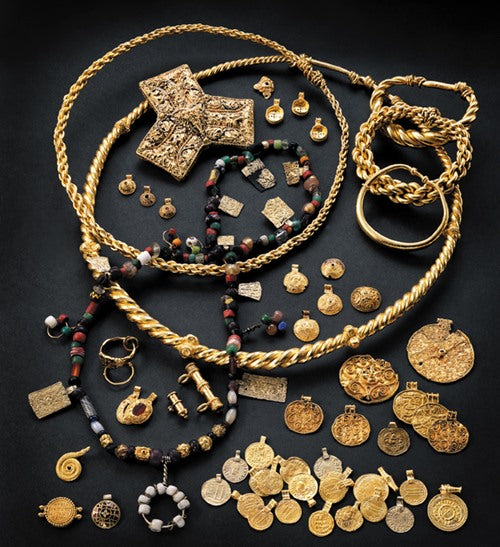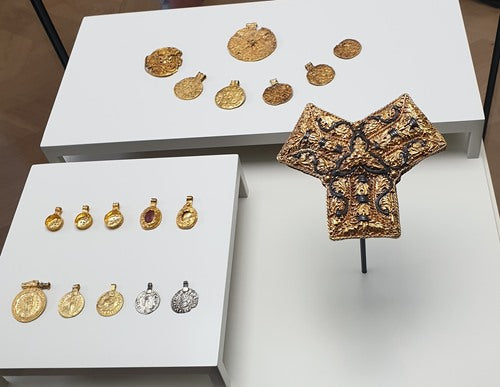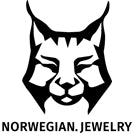VÍKINGR - Gold Jewelry from the Viking Age
Posted on July 15 2019

The VÍKINGR exhibition at the Museum of Cultural History in Oslo offers a view of the most glamorous and romanticized objects from the Viking Age (780 – 1050 AD). The display is expected to last five years. It covers not only weapons but also jewelry, produced locally and acquired during travels from trading and pillaging. Furthermore, the artifacts illustrate an emerging era of travel and interaction during the of the Dark Ages (500-1500).

The Hoen Hoard from Buskerud Norway. Photo by Ove Holst.
Digging in a Marsh
In 1834, while digging a ditch in a marsh, a laborer discovered the find (photographed above) when his spade got stuck in the large gold ring. He informed the farmer, which he worked for. Instead of keeping the 2.5 kg treasure for himself, he decided that the treasure belonged to the country. So, he traveled to Oslo and presented it to the Norwegian Parliament. The politicians were speechless. After much discussion, Parliament awarded the farmer with a substantial payment, which he shared with the laborer.
Silver was the metal of choice for jewelry during the Viking era and in Norway today. However, this find was mostly gold, making it extraordinary. Finding gold from this era is extremely rare and difficult. Much of it has been recycled repeatedly into newer jewelry over the years. Originating from different historical periods and locales, the antiquities come from Rome, Byzantium (Turkey), England (Anglo-Saxons), and France (Franks). Moreover, the hoard reveals adaptation: modification and alteration of existing designs to suit current needs. In the design itself, we also see the transfer and sharing of ideas from culture to another.
Highlighted Pieces

The Braided Bracelet (ca. 875-900 AD): Source NRK, Photo by Harald Inderhaug
This sturdy gold bracelet weighs about 400 grams – almost one pound! Relatively prevalent during the Viking Age, examples in various forms (bracelets, rings, and necklaces) have been found throughout Europe. Although not practical to wear today, the over 1000-year-old design has inspired modern adaptations like those of Dutch designer Leen Heyne.

The Red Carnelian Pendant. Photo by Ellen C Holte, Museum of Cultural History
This pendant charts a journey through time, adapting to each situation as well as taking something from each period, which it was active. The centerpiece is a red carnelian, engraved during Roman times (ca. 200 AD) that depicts a satyr (a figure from Greek mythology representing excess and gluttony). Several hundred years later, the stone found itself in the Kingdom of Charles the Great (The Franks ca. 800 AD). Charlemagne and his descendants were fascinated by Roman culture. They often reused or copied elements from the fallen empire. Adapted into a Carolingian gold pendant, it eventually found its way to Scandinavia as part of a Viking Necklace (ca. 900-1000 AD).


The Carolingian Trefoil (late 800s). Photo: Museum of Cultural History
The three-armed mount originally belonged to a baldric (sword belt), worn by military officers in the Carolingian court. The design and intricate patterns (made from silver, copper, lead, and borax) indicate rank in the Frankish army. When the object found its way to Scandinavia, a pin was attached to the back, transforming it into a fashionable brooch.
Gold's Importance
The Hoen Hoard (Hoenskatten) demonstrates the timelessness of gold and perhaps offers us a deeper understanding of what is money. Able to wear or trade, the currency of antiquity was solid, brilliant, offered utility, and independent of governments. The money itself contained the value in the form of a scarce metal, universally accepted and considered beautiful worldwide no matter the form (known as intrinsic value). We hope to see a revival in the use of gold to make jewelry. The possibilities could be limitless – recreating pieces from past in precise detail or adapting them to contemporary forms and uses: cell phone cases, smartwatch bands, or digital rings containing a payment or identification RFID.
References
VÍKINGR (Book) – Journeys, War, and Belief in a Time of Transition. Multiple Authors, Catalogue for the Viking Age exhibition, Historical Museum, 2018. The University of Oslo.
The University of Oslo: Museum of Cultural History
På spade hang det plutselig en ring av gull, NRK, Ingvild-Anita Velde Køsling, March 31, 2019

